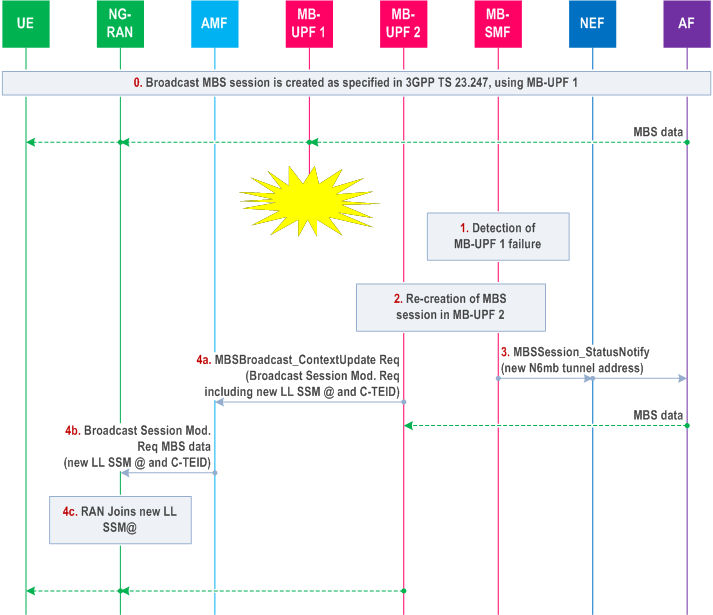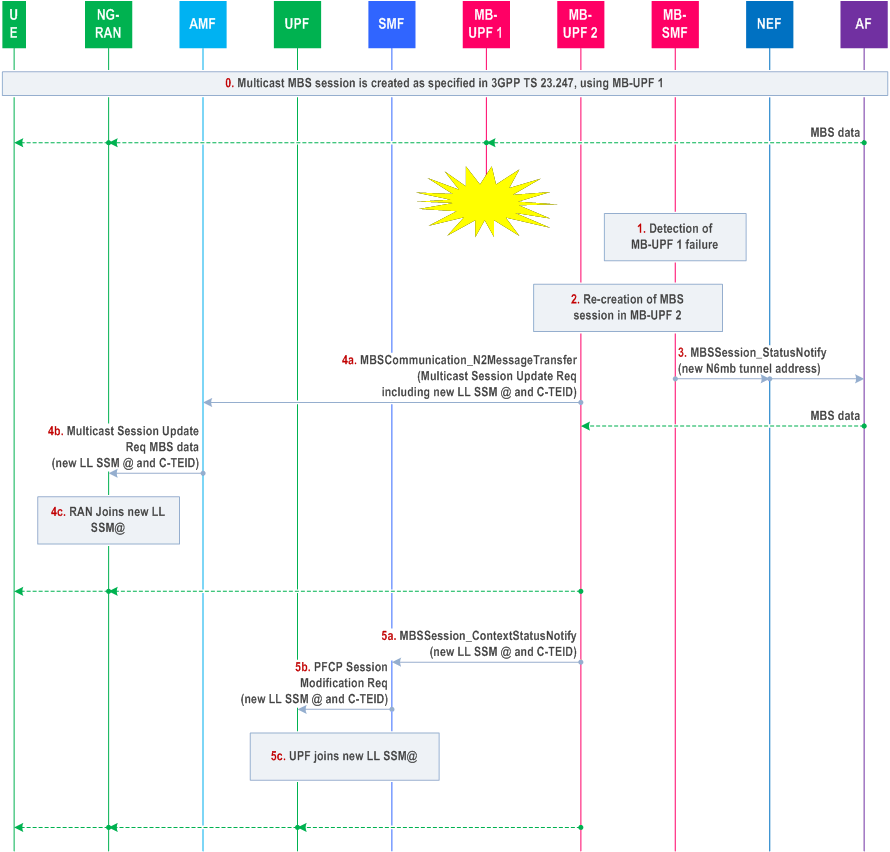Content for TS 23.527 Word version: 19.0.0
8 Restoration Procedures for MBS
8.1 General
8.1A N4mb Failure and Restart Detection
8.1B N3mb Path Failure Detection
8.2 Restoration procedures for MB-UPF failure with or without restart
8.2.1 General
8.2.2 Restoration Procedure for MB-UPF Restart
8.2.3 Restoration Procedure for MB-UPF failure without Restart
...
...
8 Restoration Procedures for MBS |R17| p. 37
8.1 General p. 37
This clause specifies the procedures supported in the 5G System to detect and handle failures affecting any network entity involved in the delivery of broadcast and/or multicast service.
8.1A N4mb Failure and Restart Detection p. 37
Across PFCP based interfaces, an MB-SMF and MB-UPF shall utilize the PFCP Heartbeat Request and Heartbeat Response messages to detect a peer PFCP entity failure or restart as described in clause 19A of TS 23.007.
A PFCP function shall ignore the Recovery Timestamp received in PFCP Association Setup Request and PFCP Association Setup Response messages (see clause 6.2.6 of TS 29.244).
8.1B N3mb Path Failure Detection |R18| p. 37
The MB-UPF may detect a N3mb path failure, when unicast transport is used over the N3mb interface, by using GTP-U Echo Request and Echo Response messages, as specified in clause 20.3.1 of TS 23.007.
8.2 Restoration procedures for MB-UPF failure with or without restart p. 37
8.2.1 General p. 37
When an MB-UPF fails, all its PFCP session contexts of the MBS sessions and all its PFCP associations affected by the failure may be lost.
The MB-SMF and MB-UPF may support the procedures specified in this clause to restore the multicast and broadcast MBS sessions affected by the failure.
8.2.2 Restoration Procedure for MB-UPF Restart p. 38
The MB-UPF should ensure that:
- when multicast transport is used on N3mb and/or N19mb, any N3mb and/or N19mb Low Layer Source Specific Multicast (LL SSM) addresses used by the MB-UPF before the MB-UPF restart are not immediately reused after the MB-UPF restart; and
- when unicast transport is used on N6mb and/or Nmb9, any N6mb and/or Nmb9 ingress tunnel addresses used by the MB-UPF before the MB-UPF restart are not immediately reused after the MB-UPF restart.
- If multicast transport is used on N3mb and/or N19mb, the MB-SMF shall additionally provide, in the Multicast Transport Information for N3mb and/or N19mb IE in the PFCP Session Establishment Request, the N3mb and/or N19mb LL SSM address and GTP-U Common TEID (C-TEID) that was previously used for the MBS session, and the MB-UPF shall allocate the same N3mb and/or N19mb LL SSM address and C-TEID to the PFCP session if possible. The MB-SMF shall not set the PLLSSM flag in the MBSN4mbReq-Flags IE in the PFCP Session Establishment Request.
- If unicast transport is used on N6mb and/or Nmb9, the MB-SMF shall additionally provide, in the "Local Ingress Tunnel" IE in the Create PDR IE or Create Tunnel Endpoint IE (for the downlink PDRs) in the PFCP Session Establishment Request, the N6mb and/or Nmb9 ingress tunnel address that was previously used for the MBS session, and the MB-UPF shall allocate the same N6mb and/or Nmb9 ingress tunnel address if possible. The MB-SMF shall not set the CHOOSE bit to "1" in the "Local Ingress Tunnel" IE. If multicast transport is used on N3mb and/or N19mb and the MB-UPF cannot accept the requested N3mb and/or N19mb LL SSM address, or if unicast transport is used on N6mb and/or Nmb9 and the UPF cannot accept the requested N6mb and/or Nmb9 ingress tunnel address, because the requested address is not available at the MB-UPF, the MB-UPF shall reject the PFCP Session Establishment Request with the cause "PFCP session restoration failure due to requested resource not available". The MB-SMF may then proceed as specified for the restoration procedure for MB-UPF failure without restart, but possibly using the same or a different MB-UPF.
8.2.3 Restoration Procedure for MB-UPF failure without Restart p. 38
Upon detecting that an MB-UPF fails without restart, the MB-SMF may restore the MBS sessions that were served by the failed MB-UPF by selecting an alternative MB-UPF and by restoring the PFCP sessions of the MBS sessions in the alternative MB-UPF, following PFCP requirements for establishing an N4mb PFCP session as specified in clause 5.34.2 of TS 29.244 with the following additions:
- the MB-SMF shall request the alternative MB-UPF to join the multicast tree towards the Source Specific Multicast (SSM) address information earlier provided by AF/AS or MBSTF, if multicast transport is used over N6mb and/or Nmb9;
- the MB-SMF shall request the alternative MB-UPF to allocate a new N6mb and/or Nmb9 ingress tunnel address, if unicast transport is used over N6mb and/or Nmb9;
- the MB-SMF shall request the alternative MB-UPF to allocate a new N3mb and/or N19mb LL SSM address and C-TEID, if multicast transport is used over N3mb and/or N19mb; and
- for each N3mb and/or N19mb endpoint expected to receice the MSB session data, the MB-SMF shall request the alternative MB-UPF to send data towards the N3mb and/or N19mb endpoint's DL F-TEID, if unicast transport is used over N3mb and/or N19mb.
- a new N3mb and/or N19mb LL SSM address and C-TEID, if multicast transport is used on N3mb and/or N19mb; and/or
- a new N6mb and/or Nmb9 ingress tunnel address, if unicast transport is used on N6mb and/or Nmb9.
-
if multicast transport is used on N3mb:
-
the MB-SMF shall update the AMFs handling the multicast or broadcast MBS session, or location dependent component of the MBS session, about the new N3mb LL SSM address and C-TEID by sending:
-
an Namf_
MBSCommunication_ request (Multicast Session Update Request including the new MB-UPF LL SSM address and C-TEID) for a multicast MBS session; and/orN2MessageTransfer -
an Namf_
MBSBroadcast ContextUpdate Request (Broadcast Session Modification Request including the new MB-UPF LL SSM address and C-TEID) for a broadcast MBS session.
-
an Namf_
- the AMFs shall forward the above information towards the NG-RAN nodes handling the MBS session (using the Multicast Session Update and Broadcast Session Modification procedures respectively);
- the NG-RAN nodes shall join delivery from the new multicast transport address to receive MBS session data from the new MB-UPF and leave delivery from the previous multicast address in use for the MBS session.
-
the MB-SMF shall update the AMFs handling the multicast or broadcast MBS session, or location dependent component of the MBS session, about the new N3mb LL SSM address and C-TEID by sending:
-
if multicast transport is used on N19mb, for a multicast MBS session:
-
the MB-SMF shall update the SMF handling the multicast MBS session, or location dependent component of the MBS session, about the new N19mb LL SSM address and C-TEID by sending an Nmbsmf_
MBSSession_ request including an "MULT_TRANS_ADD_CHANGE" event and the new N19mb LL SSM address and C-TEID used for the MBS data delivery over N19mb;ContextStatusNotify - the SMF shall update the UPF terminating the N19mb tunnel about the new LL SSM address and C-TEID;
- the UPF shall join delivery from the new multicast transport address to receive MBS session data from the new MB-UPF and leave delivery from the previous multicast address in use for the MBS session.
-
the MB-SMF shall update the SMF handling the multicast MBS session, or location dependent component of the MBS session, about the new N19mb LL SSM address and C-TEID by sending an Nmbsmf_
-
if unicast transport is used on N6mb and/or Nmb9:
-
the MB-SMF shall update the AF/NEF/MBSF about the new N6mb/Nmb9 ingress tunnel address to use for sending MBS data for a given MBS session, or location dependent component of the MBS session, by sending an Nmbsmf_
MBSSession_ request including an "Ingress Tunnel Address Change" event and the new N6mb/Nmb9 ingress tunnel address;StatusNotify - the AF/MBSF shall start sending MBS data to the new N6mb/Nmb9 ingress tunnel address.
-
the MB-SMF shall update the AF/NEF/MBSF about the new N6mb/Nmb9 ingress tunnel address to use for sending MBS data for a given MBS session, or location dependent component of the MBS session, by sending an Nmbsmf_

